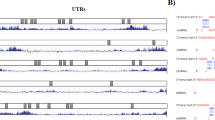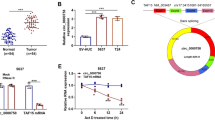Abstract
Background
Specificity protein 1 (SP1) was found to play a critical role in the regulation of TGF-β1 driven epithelial-mesenchymal transition (EMT). Recent clinical findings demonstrated a significant drop in the expression of miR-128-3p with the cancer progression in breast cancer patients. However, the impact of miR-128-3p on the SP1 expression in breast cancer remains unknown. Herein, we evaluated the role of miR-128-3p mimics in suppressing EMT of breast cancer cell lines by regulating the TGF-β1/SP1 axis.
Methods
miR-128-3p interaction with SP1 was detected by in silico tools and dual-luciferase reporter assay. qPCR, western blot, and immunocytochemistry experiments were conducted for determining the expression levels of miR-128-3p and EMT markers with and without the treatment of miR-128-3p mimics. Further, to understand the effect of miR-128-3p mimics on cancer progression, experiments such as wound healing assay, transwell assay, adhesion assay, and cell cycle analysis were performed.
Results
A significant inverse relation between SP1 and miR-128-3p levels was found in MCF-7 and MDA-MB-231 cell lines. miR-128-3p overexpression impeded the SP1 mediated EMT markers in TGF-β1 stimulated cells by inhibiting the SP1 nuclear function. Further, treatment with miR-128-3p mimics significantly reduced the migration, invasion and spreading capability of TGF-β1 stimulated cells. Flow cytometry results showed the impeding role of miR-128-3p on the cell cycle progression.
Conclusions
Upregulated miR-128-3p inhibited SP1, thereby limiting the TGF-β1 induced EMT in MCF-7 and MDA-MB-231 cell lines for the first time. This study may pave the path to explore novel miRNA therapeutics for eradicating advanced breast cancer cases.




Similar content being viewed by others
Data availability
All data generated or analysed during this study are included in this published article.
References
Zarzynska JM (2014) Two faces of TGF-beta1 in breast cancer. Mediat inflamm 2014:1–16
Yang P, Zhang Y, Markowitz GJ, Guo X, Wang X-F (2016) TGF-β-regulated microRNAs and their function in cancer biology. TGF-β signaling. Springer, New York, pp 325–339
Jungert K, Buck A, von Wichert G, Adler G, König A, Buchholz M et al (2007) Sp1 is required for transforming growth factor-β–induced mesenchymal transition and migration in pancreatic cancer cells. Can Res 67(4):1563–1570
Zhang X, Yang H, Jia Y, Xu Z, Zhang L, Sun M et al (2021) circRNA_0005529 facilitates growth and metastasis of gastric cancer via regulating miR-527/Sp1 axis. BMC Mol Cell Biol 22(1):1–15
Chen M, Gao Y, Gan K, Liu K, Xu B (2021) SP1 expression and the clinicopathological features of tumors: a meta-analysis and bioinformatics analysis. Pathol Oncol Res. https://doi.org/10.3389/pore.2021.581998
Safe S, Shrestha R, Mohankumar K, Howard M, Hedrick E, Abdelrahim M (2021) Transcription factors specificity protein and nuclear receptor 4A1 in pancreatic cancer. World J Gastroenterol 27(38):6387
Zhao Y, Zhang W, Guo Z, Ma F, Wu Y, Bai Y et al (2013) Inhibition of the transcription factor Sp1 suppresses colon cancer stem cell growth and induces apoptosis in vitro and in nude mouse xenografts. Oncol Rep 30(4):1782–1792
Tian Y, Ma R, Sun Y, Liu H, Zhang H, Sun Y et al (2020) Correction: SP1-activated long noncoding RNA lncRNA GCMA functions as a competing endogenous RNA to promote tumor metastasis by sponging miR-124 and miR-34a in gastric cancer. Oncogene 39(42):6621
Zhao Y, Ma J, Fan Y, Wang Z, Tian R, Ji W et al (2018) TGF-β transactivates EGFR and facilitates breast cancer migration and invasion through canonical Smad3 and ERK/Sp1 signaling pathways. Mol Oncol 12(3):305–321
Peng Y, Croce CM (2016) The role of microRNAs in human cancer. Signal Transduct Target Ther 1(1):1–9
Turashvili G, Lightbody ED, Tyryshkin K, SenGupta SK, Elliott BE, Madarnas Y et al (2018) Novel prognostic and predictive microRNA targets for triple-negative breast cancer. FASEB J 32(11):5937–5954
Block I, Burton M, Sørensen KP, Andersen L, Larsen MJ, Bak M et al (2018) Association of miR-548c-5p, miR-7-5p, miR-210-3p, miR-128-3p with recurrence in systemically untreated breast cancer. Oncotarget 9(10):9030
Liu S, Chen W, Hu H, Zhang T, Wu T, Li X et al (2021) Long noncoding RNA PVT1 promotes breast cancer proliferation and metastasis by binding miR-128-3p and UPF1. Breast Cancer Res 23(1):1–13
Chen Y, Wu N, Liu L, Dong H, Liu X (2020) microRNA-128-3p overexpression inhibits breast cancer stem cell characteristics through suppression of Wnt signalling pathway by down-regulating NEK2. J Cell Mol Med 24(13):7353–7369
Zhao J, Li D, Fang L (2019) MiR-128-3p suppresses breast cancer cellular progression via targeting LIMK1. Biomed Pharmacother 115:108947
Wang D, Chen F, Fang B, Zhang Z, Dong Y, Tong X et al (2020) MiR-128–3p alleviates spinal cord ischemia/reperfusion injury associated neuroinflammation and cellular apoptosis via SP1 suppression in rat. Front Neurosci. https://doi.org/10.3389/fnins.2020.609613
Cao F, Li Z, Ding W-M, Yan L, Zhao Q-Y (2019) LncRNA PVT1 regulates atrial fibrosis via miR-128-3p-SP1-TGF-β1-Smad axis in atrial fibrillation. Mol Med 25(1):1–11
Gondaliya P, Dasare AP, Jash K, Tekade RK, Srivastava A, Kalia K (2019) miR-29b attenuates histone deacetylase-4 mediated podocyte dysfunction and renal fibrosis in diabetic nephropathy. J Diabetes Metab Disord. https://doi.org/10.1007/s40200-019-00469-0
Justus CR, Leffler N, Ruiz-Echevarria M, Yang LV (2014) In vitro cell migration and invasion assays. J Visualized Exp. https://doi.org/10.3791/51046
Kim KH, Sederstrom JM (2015) Assaying cell cycle status using flow cytometry. Curr Protoc Mol Biol 111(1):28.6.1–28.6.11
Jariyal H, Gupta C, Andhale S, Gadge S, Srivastava A (2021) Comparative stemness and differentiation of luminal and basal breast cancer stem cell type under glutamine-deprivation. J Cell Commun Signal 15(2):207–222
Xu J, Lamouille S, Derynck R (2009) TGF-β-induced epithelial to mesenchymal transition. Cell Res 19(2):156–172
Bellomo C, Caja L, Moustakas A (2016) Transforming growth factor β as regulator of cancer stemness and metastasis. Br J Cancer 115(7):761–769
Zhuang X, Wang J (2018) Correlations of MRP1 gene with serum TGF-beta 1 and IL-8 in breast cancer patients during chemotherapy. J BUON 23(5):1302–1308
Drabsch Y, Ten Dijke P (2011) TGF-β signaling in breast cancer cell invasion and bone metastasis. J Mammary Gland Biol Neoplasia 16(2):97–108
Li T, Huang H, Shi G, Zhao L, Li T, Zhang Z et al (2018) TGF-β1-SOX9 axis-inducible COL10A1 promotes invasion and metastasis in gastric cancer via epithelial-to-mesenchymal transition. Cell Death Dis 9(9):1–18
Zheng K, Yu J, Chen Z, Zhou R, Lin C, Zhang Y et al (2019) Ethanol promotes alcohol-related colorectal cancer metastasis via the TGF-β/RUNX3/Snail axis by inducing TGF-β1 upregulation and RUNX3 cytoplasmic mislocalization. EBioMedicine 50:224–237
Qian P, Banerjee A, Wu Z-S, Zhang X, Wang H, Pandey V et al (2012) Loss of SNAIL regulated miR-128–2 on chromosome 3p22.3 targets multiple stem cell factors to promote transformation of mammary epithelial cells. Cancer Res 72(22):6036–6050
Tan NY, Khachigian LM (2009) Sp1 phosphorylation and its regulation of gene transcription. Mol Cell Biol 29(10):2483–2488
Qian Y, Yao W, Yang T, Yang Y, Liu Y, Shen Q et al (2017) aPKC-ι/P-Sp1/Snail signaling induces epithelial–mesenchymal transition and immunosuppression in cholangiocarcinoma. Hepatology 66(4):1165–1182
Cram EJ, Liu BD, Bjeldanes LF, Firestone GL (2001) Indole-3-carbinol inhibits CDK6 expression in human MCF-7 breast cancer cells by disrupting Sp1 transcription factor interactions with a composite element in the CDK6 gene promoter. J Biol Chem 276(25):22332–22340
Acknowledgements
Amit Khairnar gratefully acknowledges the support of the Ramalingaswami fellowship (No. BT/RLF/Re-entry/24/2017) from the Department of Biotechnology, India.
Funding
This supplement was supported by the seed fund of the National Institute of Pharmaceutical Education and Research (NIPER)-Ahmedabad, Department of Pharmaceutics, Ministry of Chemicals and Fertilizers, Government of India.
Author information
Authors and Affiliations
Corresponding author
Ethics declarations
Conflict of interest
The authors declared no conflicts of interest.
Ethical approval
This article does not contain any studies with human participants performed by any of the authors.
Additional information
Publisher's Note
Springer Nature remains neutral with regard to jurisdictional claims in published maps and institutional affiliations.
Supplementary Information
Below is the link to the electronic supplementary material.
Rights and permissions
About this article
Cite this article
Nalla, L.V., Gondaliya, P., Kalia, K. et al. Targeting specificity protein 1 with miR-128-3p overcomes TGF-β1 mediated epithelial-mesenchymal transition in breast cancer: An in vitro study. Mol Biol Rep 49, 6987–6996 (2022). https://doi.org/10.1007/s11033-022-07466-2
Received:
Accepted:
Published:
Issue Date:
DOI: https://doi.org/10.1007/s11033-022-07466-2




